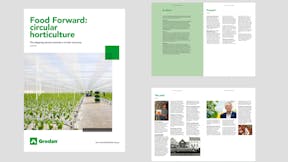A major discovery
It started somewhere in 1969, when Piet was triggered by an article in a trade magazine:
“I read there was a ROCKWOOL test greenhouse in Sweden where cucumbers were grown on stone wool. That was something I had to see. So, somewhere in the autumn of 1975, I went on a work visit to Sweden and Denmark, together with Royal Brinkman,” tells Piet enthusiastically.
During this trip, Piet discovered that stone wool growing media made a significant contribution to the sustainable production of fresh food:
“If you plant a cucumber in soil, the plant has to use energy to obtain water and nutrition. But we found out that on stone wool, the cucumber needs a lot less energy. The plant will then put the stored energy into its fruit. Back then we had no idea that the extra yield would be so high.”

Minimizing water wastage
At the test greenhouse in Sweden, Piet and his partners from Royal Brinkman also learned about a solution to minimize water wastage in cultivation: drip irrigation. This method, originally from Israel, turned out to be the start of precision growing in the horticulture sector.
Piet: “We discovered that the soil no longer needed to be steamed or heated in winter. Meanwhile, production increased by 15 percent per square meter with less energy consumption and no extra crop protection products – all thanks to precise drip irrigation. You can irrigate the soil completely or give the plant exactly what it needs.”
An instant success
Van Adrichem and Royal Brinkman’s Gerrit Dijkstra saw a huge opportunity during their trip, and decided to order four hundred square meters of stone wool substrates.
Van Adrichem: “Back in 1975, together with my brother Wim, I leveled our entire greenhouse in Pijnacker, laid all the mats and switched over completely. It was an instant success. These cucumbers proved to have a better shelf life and better taste, and they even shone more. After Grodan settled in the Netherlands in 1978, things went really fast. By the 1990’s almost all greenhouse growers in the country had adopted stone wool substrate. Less than two years later, in the 1980’s, branch advisors from all over the Netherlands were on our doorstep out of curiosity. Because we could help save lots of water.”
Nowadays, according to Piet, drip irrigation is common all over the world and is saving lots of water worldwide.


Download the whitepaper about circular horticulture
Download the whitepaper about circular horticulture and read about more whatcircular horticulture is and how it can help you.









